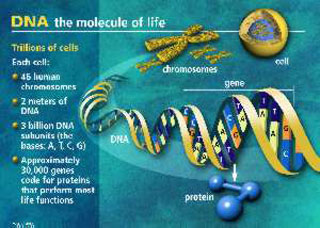This article was originally published in Maclean's Magazine on July 10, 1995
Alzheimer's Gene Found
Frances Hodge was only 47 when Alzheimer's disease began to destroy her brain. The first symptoms appeared in 1975, when her memory began to fail. By the early 1980s, she could no longer talk, and in 1986 she entered a nursing home, where she remained until her death four months ago. Although most victims of the type of Alzheimer's that strikes the relatively young die within 10 years, Fran Hodge had lived with the disease for 20. "She just faded away," said her grieving husband, Toronto businessman Bruce Hodge. "To the world, she was a vegetable, but to me she was still Fran - a human being with her own values." Despite the strides that scientists have made during the past decade in understanding an illness that afflicts more than 250,000 Canadians, Alzheimer's remains a baffling disease for which there are few effective treatments - and no cure. Last week, there was at least a glimmer of hope. In a dramatic breakthrough, University of Toronto scientists revealed in the British scientific journal Nature that they had cloned a flawed gene that is responsible for most cases of early-onset Alzheimer's. The discovery was hailed as a major finding that could lead eventually to ways of intervening to slow or halt the ravages of the disease.
It also means that, in the future, a blood test will be used to detect the presence of the early-onset gene, which can cause Alzheimer's in people as young as 30. In its more widespread form, Alzheimer's usually strikes after the age of 65 and is thought to be caused by both genetic and environmental factors. The early-onset form is caused by inheritance alone. Before the latest discovery, scientists had identified two other Alzheimer-related genes, but neither opened the way to new treatments. The new finding may hold more promise. Even though the early-onset form of Alzheimer's is relatively rare - it is probably responsible for fewer than 10 per cent of all cases - the newly discovered gene is likely to shed light on the processes underlying all cases of Alzheimer's. "With luck," said Dr. Creighton Phelps, who supervises research programs at the U.S. National Institute on Aging in Bethesda, Md., "this finding might someday help us to prevent or slow the development of Alzheimer's."
It could take several more years to determine what role the gene plays. But Dr. Peter St. George-Hyslop, the geneticist and neurologist who led the U of T team, speculated that a protein controlled by the gene could play a key part in producing a substance called beta-amyloid, which attacks and kills brain cells in Alzheimer's victims. If that proves to be the case, added St. George-Hyslop, "we can begin to look for ways to shift the metabolism away from producing this substance."
By cloning the gene, the U of T team won a major scientific race that began three years ago. Almost simultaneously, his laboratory and two other labs discovered that a genetic defect on the 14th chromosome - one of the 46 inherited gene clusters stored in the nucleus of most human cells - plays an important role in early-onset Alzheimer's. As a first step in finding the gene, the Canadian researchers examined genetic inheritance patterns in a number of large families with long histories of inherited Alzheimer's. Their goal was to identify genetic "markers" that would point to the gene's location. By 1994, the team had narrowed the search to a region on the chromosome containing several hundred genes.
At that point, the gene detectives decided to see whether the ethnic makeup of some of the large families they were studying - including Jewish-American and Italian families, as well as an eastern Canadian family of Anglo-Saxon-Celtic extraction - could be used to narrow the search. "We assumed," said St. George-Hyslop, "that each of these families would have a single ancestor with the flawed gene and that they would carry genetic markers inherited from that ancestor in the region of the gene we were looking for." In several of the families, telltale patterns did emerge, and although they were different in each family, they pointed to the same genetic regions. By testing genetic material from brain tissue taken from Alzheimer's victims, U of T medical geneticist Johanna Rommens reduced the number of suspect genes to just 16.
Further tests and a process of elimination narrowed the hunt to seven genes. Finally, one gene - dubbed S182 - emerged as the villain. "This gene showed mutations specific to people with the disease," St. George-Hyslop said, "and it predicted the presence of the disease. At that point, we had solid evidence."
With the cloning of the gene, the stage is now set for another race as scientists try to understand the function of gene S182. The protein produced by the gene, said protein chemist Paul Fraser, a member of the U of T team, "is a membrane protein which builds either the outside coating or some internal structure in cells." Understanding the gene's function, said St. George-Hyslop, is likely to be significant not only for early-onset Alzheimer's, but for all forms of the disease. For now, said Steve Rudin, executive director of the Alzheimer's Society of Canada, the fact that the gene has been identified "is tremendously important, because it gives hope to people that progress is being made in understanding this terrible disease."
Maclean's July 10, 1995

 Share on Facebook
Share on Facebook Share on X
Share on X Share by Email
Share by Email Share on Google Classroom
Share on Google Classroom


